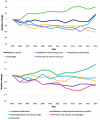Hospitalization rates from radiotherapy complications in the United States
- PMID: 35288636
- PMCID: PMC8921251
- DOI: 10.1038/s41598-022-08491-8
Hospitalization rates from radiotherapy complications in the United States
Abstract
Hospitalizations due to radiotherapy (RT) complications result in significant healthcare expenditures and adversely affect the quality of life of cancer patients. Using a nationally representative dataset, the objective of this study is to identify trends in the incidence of these hospitalizations, their causes, and the resulting financial burden. Data from the National Inpatient Sample was retrospectively analyzed from 2005 to 2016. RT complications were identified using ICD-9 and ICD-10 external cause-of-injury codes. The hospitalization rate was the primary endpoint, with cost and in-hospital death as secondary outcomes. 443,222,223 weighted hospitalizations occurred during the study period, of which 482,525 (0.11%) were attributed to RT. The 3 most common reasons for RT-related hospitalization were cystitis (4.8%, standard error [SE] = 0.09), gastroenteritis/colitis (3.7%, SE = 0.07), and esophagitis (3.5%, SE = 0.07). Aspiration pneumonitis (1.4-fold) and mucositis (1.3-fold) had the highest relative increases among these hospitalizations from 2005 to 2016, while esophagitis (0.58-fold) and disorders of the rectum and anus were the lowest (0.67-fold). The median length of stay of patient for hospitalization for RT complications was 4.1 (IQR, 2.2-7.5) days and the median charge per patient was $10,097 (IQR, 5755-18,891) and the total cost during the study period was $4.9 billion. Hospitalization for RT-related complications is relatively rare, but those that are admitted incur a substantial cost. Use of advanced RT techniques should be employed whenever possible to mitigate the risk of severe toxicity and therefore reduce the need to admit patients.
© 2022. The Author(s).
Conflict of interest statement
R. Tonse, M. Rubens, V. Ramamoorthy, A. Saxena, E. Veledar, P. McGranaghan: None. M. Hall: Honorarium from Accuray, Inc. Proton Collaborative Group Executive Committee Institutional Representative and Voting Member, Miami Cancer Institute (unpaid). Grant Funding: Live Like Bella Pediatric Cancer Research Initiative, Florida Department of Health Grant 8LA04. M. Chuong: Honorarium from Accuray, Inc., ViewRay Inc., Sirtex Inc. Advisory board for ViewRay, Inc. Research funding from ViewRay, Inc., Novocure, Inc., AstraZeneca, Inc. M. S. Ahluwalia: Receipt of grants/research supports: Astrazeneca, BMS, Bayer, Incyte, Pharmacyclics, Novocure, Mimivax, Merck. Receipt of honoraria or consultation fees: Bayer, Novocure, Kiyatec, Insightec, GSK, Nuvation, Cellularity, Apollomics. Stock shareholder: Doctible, Mimivax, Cytodyn. M. P. Mehta: Consulting for Karyopharm, Sapience, Zap, Mevion. Board of Directors: Oncoceutics. R. Kotecha: Honoraria from Accuray Inc., Elekta AB, Viewray Inc., Novocure Inc., Elsevier Inc. Institutional research funding from Medtronic Inc., Blue Earth Diagnostics Ltd., Novocure Inc., GT Medical Technologies, Astrazeneca, Exelixis, Viewray Inc.
Figures


Similar articles
-
Hospitalization rates for complications due to systemic therapy in the United States.Sci Rep. 2021 Apr 1;11(1):7385. doi: 10.1038/s41598-021-86911-x. Sci Rep. 2021. PMID: 33795827 Free PMC article.
-
Trend and burden of adult cancer-related hospitalizations in the United States.Sci Rep. 2025 Apr 18;15(1):13388. doi: 10.1038/s41598-025-97310-x. Sci Rep. 2025. PMID: 40251325 Free PMC article.
-
Trends in Alcoholic Hepatitis-related Hospitalizations, Financial Burden, and Mortality in the United States.J Clin Gastroenterol. 2015 Jul;49(6):506-11. doi: 10.1097/MCG.0000000000000161. J Clin Gastroenterol. 2015. PMID: 25198164 Free PMC article.
-
Tuberculosis management continues to utilize a large amount of hospital resources in the United States.Clin Respir J. 2017 Jan;11(1):21-27. doi: 10.1111/crj.12296. Epub 2015 Apr 29. Clin Respir J. 2017. PMID: 25833672
-
Racial disparities in ventricular tachycardia in young adults: analysis of national trends.J Interv Card Electrophysiol. 2023 Jan;66(1):193-202. doi: 10.1007/s10840-022-01335-5. Epub 2022 Aug 10. J Interv Card Electrophysiol. 2023. PMID: 35947319 Review.
Cited by
-
Out of field scatter from electron applicator in modern linear accelerators.J Appl Clin Med Phys. 2024 Jun;25(6):e14265. doi: 10.1002/acm2.14265. Epub 2024 Feb 9. J Appl Clin Med Phys. 2024. PMID: 38335230 Free PMC article.
-
Radioprotection of healthy tissue via nanoparticle-delivered mRNA encoding for a damage-suppressor protein found in tardigrades.Nat Biomed Eng. 2025 Feb 26. doi: 10.1038/s41551-025-01360-5. Online ahead of print. Nat Biomed Eng. 2025. PMID: 40011582
-
Esophageal Circumferential Dose-Length Histogram Parameters to Predict Dysphagia in Patients Receiving Thoracic Radiation Therapy: A Single-Institution Experience.Adv Radiat Oncol. 2025 May 24;10(8):101807. doi: 10.1016/j.adro.2025.101807. eCollection 2025 Aug. Adv Radiat Oncol. 2025. PMID: 40611876 Free PMC article.
-
Validation and Derivation of miRNA-Based Germline Signatures Predicting Radiation Toxicity in Prostate Cancer.Clin Cancer Res. 2025 Jun 13;31(12):2530-2538. doi: 10.1158/1078-0432.CCR-24-3951. Clin Cancer Res. 2025. PMID: 40192540 Free PMC article.
-
Efficacy and safety of transarterial chemoembolization with CalliSpheres® Microspheres in head and neck cancer.Front Surg. 2022 Aug 25;9:938305. doi: 10.3389/fsurg.2022.938305. eCollection 2022. Front Surg. 2022. PMID: 36090318 Free PMC article.
References
-
- Cancer Statistics, https://www.cancer.gov/about-cancer/understanding/statistics.
MeSH terms
LinkOut - more resources
Full Text Sources

